This post is part of our “Journey to Raw” series, published on Wednesdays, and comes to you from Brandy Cap, a semi-retired entrepreneur, writer, researcher, animal lover, and advocate for cats and people. Brandy and her husband share their home with three dogs and six cats.
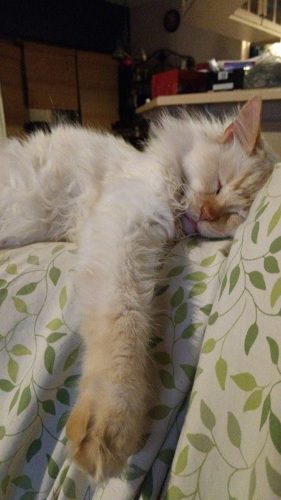 My husband and I have always had cats. When we met in late ‘94, my year-old cat, Merlin, tried to claw him to death because he decided he wanted to cuddle my not-cuddly cat and Merlin was opposed to that idea, after which, he and Merlin became inseparable. As a wedding present from us to us, in ‘97 we added a small torbie Maine Coon girl, Blaise, and a year later a beautiful silver tabby Maine Coon, Shimmer. Blaise and Shimmer were show cats, and a year later we kept a black smoke kitten, Worf, from Blaise’s only litter. They were fed Diamond kibble as per Blaise’s breeder’s suggestion, and Science Diet. We gave them cooked chicken and human-grade baby food as treats. For the next 7-8 years, life with our quartet was perfect.
My husband and I have always had cats. When we met in late ‘94, my year-old cat, Merlin, tried to claw him to death because he decided he wanted to cuddle my not-cuddly cat and Merlin was opposed to that idea, after which, he and Merlin became inseparable. As a wedding present from us to us, in ‘97 we added a small torbie Maine Coon girl, Blaise, and a year later a beautiful silver tabby Maine Coon, Shimmer. Blaise and Shimmer were show cats, and a year later we kept a black smoke kitten, Worf, from Blaise’s only litter. They were fed Diamond kibble as per Blaise’s breeder’s suggestion, and Science Diet. We gave them cooked chicken and human-grade baby food as treats. For the next 7-8 years, life with our quartet was perfect.
Then came the melamine poisoning of 2007-2008…within months Merlin lost most of his weight and practically disintegrated before our eyes before he passed. Blaise had a severe kidney issue; because we were down to one salary due to my husband’s almost career-ending injury and hospitalization and all the lack of money issues that go with that (plus the vet we were using at the time refused to accept payments), the only thing we could do was to try to make her comfortable. She was in so much pain as she passed that to this day my heart shatters when I think of what she must have gone through. We thought Worf and Shimmer had weathered whatever was happening (we believed it had something to do with our house; we had just bought it right before my husband’s injury, and had considered the possibility that there could be issues that the prior owner never divulged). Then one day Worf jumped on my lap and I realized his ears looked YELLOW. Jaundice. He passed away from liver issues. Shimmer had started to lose weight and condition, and we still didn’t think it could be their food since the foods we were giving them weren’t on the ‘voluntary recall’ lists.
We had bred Shimmer and Worf and kept one kitten, Gus. We somehow (because it’s never a good idea ‘to just go look’ at the kitty adoption corner in Petsmart) came home with Nermal, a cranky brown tabby that vaguely resembled Merlin, and a few months later, Calvin, a giant red tabby. Tyrsa, a teeny little black kitten, was found under our car when we were shopping.
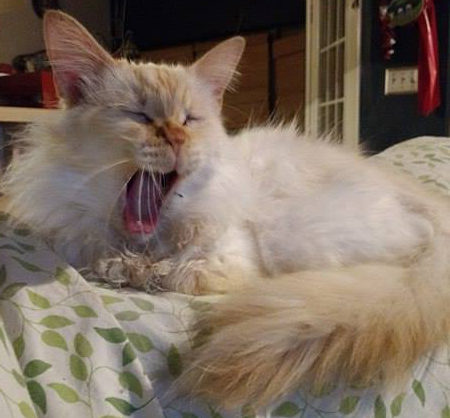 Then terrible in a two-week window in 2011, we lost Gus and Tyrsa. An otherwise healthy cat, Gus had suffered from chronic sinus issues since he was a kitten, but he seemed to go into cardiac arrest as my husband held him in his arms. We thought it could be Hypertrophic Cardiomyopathy, a disease that Maine Coon breeders dread, and which we, as a group, tend to screen our breeding cats for. Both Shimmer and Worf had been screened, and I still don’t think it was the actual cause. But when Tyrsa, younger and in much better shape (never a sniffle from her), died in the same way, I asked for a necropsy. She had toxoplasmosis, which made no sense. She never went outside, which is where most cats get exposed to it via other cats’ feces or infected vermin or birds. Since cats can be asymptomatic carriers, we thought maybe one of our rescue cats could have brought it in, but tests on Nermal and Calvin showed nothing. LM and Shimmer were also brought in, and both were also clear of toxoplasmosis.
Then terrible in a two-week window in 2011, we lost Gus and Tyrsa. An otherwise healthy cat, Gus had suffered from chronic sinus issues since he was a kitten, but he seemed to go into cardiac arrest as my husband held him in his arms. We thought it could be Hypertrophic Cardiomyopathy, a disease that Maine Coon breeders dread, and which we, as a group, tend to screen our breeding cats for. Both Shimmer and Worf had been screened, and I still don’t think it was the actual cause. But when Tyrsa, younger and in much better shape (never a sniffle from her), died in the same way, I asked for a necropsy. She had toxoplasmosis, which made no sense. She never went outside, which is where most cats get exposed to it via other cats’ feces or infected vermin or birds. Since cats can be asymptomatic carriers, we thought maybe one of our rescue cats could have brought it in, but tests on Nermal and Calvin showed nothing. LM and Shimmer were also brought in, and both were also clear of toxoplasmosis.
A few weeks before we lost Gus and Tyrsa, Little Man, or LM, joined our household. We thought he was a kitten and at 4.3 pounds, it was an honest mistake. But to me his teeth seemed ‘wrong’; they weren’t the little needles of a kitten, but a full set of adult teeth. Our vet agreed with me, and decided he was closer to the year mark, deducing his small size was probably a combination of genetics and malnourishment. He also had a sparse coat, gunk-filled ears and a voracious appetite. LM also had runny poos, which sometimes ‘hardened’ to what we called pudding poos. I thought it was simply that the shelter, with it’s tough job of trying to find homes for way too many animals and no budget to do it, had to make do with what it had and fed the stuff you can pick up for $10 for 50 pounds. We believed that once his system got used to better food, he would recover.
And he did, somewhat. My husband is a softie when it comes to the cats, and LM knows it. Giant Disney princess blue eyes, he would just LOOK at that man, who would immediately head to the fridge. Cooked chicken, luncheon meats bought specifically for LM, bags of cat treats, all found their way into LM…only to leave in a smelly mess. He gained weight, and then started to lose it, now slowly smelling like his mouth was rotting. Trips to vet ended up with a lecture against feeding luncheon meats (duh; I had been trying to get my husband to STOP feeding LM this stuff), and that he probably was sensitive to nitrates. So we come home with ‘special’ food and antibiotics for the inflamed intestines. We then figured that any damage to his intestines were probably permanent, since the runny poos had never really stopped, and adapted our household to this. We switched to foods specially formulated for “sensitive” stomachs.
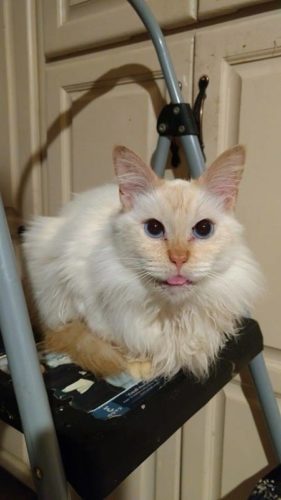 Then Nermal, also plagued with chronic sinus issues, lost his coat condition, and the more he was tempted with canned food (just so he would eat), the worse he got. But Nermal…he would get a kitty cold, then recover, then rinse, repeat, until we got complacent and he succumbed to pneumonia. Diseases that we thought were more common in indoor-outdoor cats or those in crowded, stressed conditions were still taking our cats. Well-fed (we thought), there was no reason for losing almost a cat a year! Our little pet cemetery in a corner of our yard was running out of space, and we had only been in our house 8 years.
Then Nermal, also plagued with chronic sinus issues, lost his coat condition, and the more he was tempted with canned food (just so he would eat), the worse he got. But Nermal…he would get a kitty cold, then recover, then rinse, repeat, until we got complacent and he succumbed to pneumonia. Diseases that we thought were more common in indoor-outdoor cats or those in crowded, stressed conditions were still taking our cats. Well-fed (we thought), there was no reason for losing almost a cat a year! Our little pet cemetery in a corner of our yard was running out of space, and we had only been in our house 8 years.
Still reeling from losing Nermal, we worried about 17-year old Shimmer. We attributed her loss of condition to her age, and brought in another silver Maine Coon kitten, Sophie, as her companion. Compared to all our other cats, we never had any issues with Shimmer, so while I still kept an eye on her, I focused on LM, now our next-oldest cat. He was continuing to lose weight, he always seemed to drool, but it had now morphed into ropy, smelly drool, and he often could not get to one of the many litterboxes we had in time, runny diarrhea dripping out of him. He also had what must have been painful explosive … farts. Dan calls them ‘sharts’… a combination of, well, y’know.
The vet seemed at a loss; other than prescribe him a series of antibiotics and different types of food, LM didn’t seem to get better. To be honest, we had resigned ourselves to watching yet one more cat getting ready to die. My husband, needing something to do, started giving LM pieces of cooked chicken, which the cat scarfed down like filet mignon. We started feeding him whatever he wanted (as long as it wasn’t luncheon meat); if he was going to die, at least he would be eating things he liked. But he was still losing what little weight he had, his coat was all but gone, and he was always hunched over.
One day, my husband had headed off to another ship assignment and I was preparing some chicken for LM. He was just staring listlessly at me as I pulled out the small grill to cook the chicken, so I took a sliver of still-raw meat and handed it to him. He slurped that thing down; I don’t recall he even chewed it. Licking his lips (still slobbery from ropy drool), he looked at me and I handed him another piece. Then put away the grill and took out some more chicken. After a few more pieces, I went straight to my computer and started researching, and came upon CatCentric, read every single page in the website, as well as pretty much every link from the website.
The next day I brought home some fresh meat. I opted to try the “prey model raw” diet and picked up LM’s beloved chicken breasts, chicken hearts, liver, a pack of sweetbreads (used locally in TexMex dishes). Because LM has only 4 teeth (one canine, three back molars, all in pretty sad shape), plus a chronic case of stomatitis which left his poor mouth really tender, I tossed the meats and organs in a food processor along with an entire egg, shell included, just enough to rough-chop the pieces. I then held my breath as I placed the food in front of LM. I don’t think I ever saw him eat so fast! He polished off his little plate then looked up to me, expecting more, and I was tempted. But I also know that his poor gut was still so sore, and while I did feed him a little more, it was hours later.
The next morning, I thought someone swapped cats on me. LM was sitting on my bed, staring at me with eyes that weren’t dull, but bright. He still smelled, but was alert. He was on his way back! He never needed any transition time from commercial products to fresh raw meals. Shimmer, my dear, sweet, geriatric cat, also sat in her special chair and feasted on raw until the day she passed, well into her 17th year.
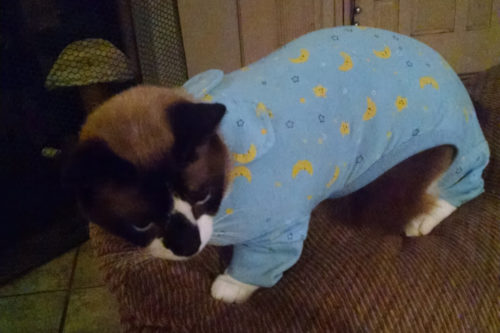 Raw has also helped with the quality of life for another of our cats, Milo. A rescue cat, he would lick himself raw to the point that I used those little ‘puppy pajamas’ and then those onesies that are used on babies and put them on him to try to slow down the damage to his skin. He was always either licking or chewing his coat, and since he has the thin coat of a Siamese, there wasn’t much there to begin with. Skin scrapings showed nothing amiss, so outside of NOT wanting to deal with dosing a cat with antidepressants, I moved him over to raw as well. My husband was skeptical, even with the results he could see with LM, he doubted food allergies could show up as skin issues.
Raw has also helped with the quality of life for another of our cats, Milo. A rescue cat, he would lick himself raw to the point that I used those little ‘puppy pajamas’ and then those onesies that are used on babies and put them on him to try to slow down the damage to his skin. He was always either licking or chewing his coat, and since he has the thin coat of a Siamese, there wasn’t much there to begin with. Skin scrapings showed nothing amiss, so outside of NOT wanting to deal with dosing a cat with antidepressants, I moved him over to raw as well. My husband was skeptical, even with the results he could see with LM, he doubted food allergies could show up as skin issues.
In the year since, ALL of our pets were switch to raw. Calvin will not eat fresh raw, but we have switched him to a freeze-dried commercial raw that resembles the kibble they used to get. I figured that since I was feeding LM and Milo raw, everyone else would get raw, so our dogs are also raw-fed. We are back to six cats; Chico came to us as a foster that never left, while Levi literally followed my husband home after he was tossed out of a car at the local jogging path.
Milo’s coat has grown back, and sometimes I think that it feels much softer than when we first got him. And as for LM…LM has gained his weight back, his coat is soft, his eyes clear. He still drools, BUT HE DOESN’T SMELL. Not a shart, or even a slight little toot. He may always have soft stools, but the only time he has had the runs since that day I gave him a piece of raw chicken was when my husband came home from one of his ships and gave him some canned cat food.
That’s the odd thing, that a roadblock to having a completely raw-fed household would be in the form of a man who watched in agony as several of his cats died. He thought it was too much hassle (it can be), took a lot of time to prepare (it is), the dogs really were being overfed (at the beginning, our large-breed puppy was getting close to 4 pounds a day) and really wasn’t necessary (until I would plop a healthy, happy cat on his lap). And then I would remind him of the pet cemetery out back, and wonder just how many of them were there because the food had compromised their immune systems or weakened their bodies so that they couldn’t heal themselves. My vet also is totally anti-raw (and I will probably get ‘fired’ as a client if she ever reads this); I understand that many pets have lived long, apparently healthy lives on commercial kibble, but mine didn’t.
The past decade has tested our resolve to be good pet owners. We fed the best food we could find, kept them in a good, clean home, loved them, catered to them, and felt another chunk of our hearts shredded when they died too young and for the stupidest reasons…their food. Food which we expected to be nutritionally balanced, SAFE, and when we looked closer into what is in it, realized that all those vague ingredients and ‘byproducts’ could compromise our pets’ lives. Had I not seen firsthand the complete turnaround in LM, I would never have thought that food could hurt, even inadvertently. I was diagnosed with an autoimmune disorder that has its own set of nutritional issues, and had I not put LM on the road to recovery by changing what he was eating, I would not now be open-minded to making the necessary changes in my own diet so I, too, can recover.
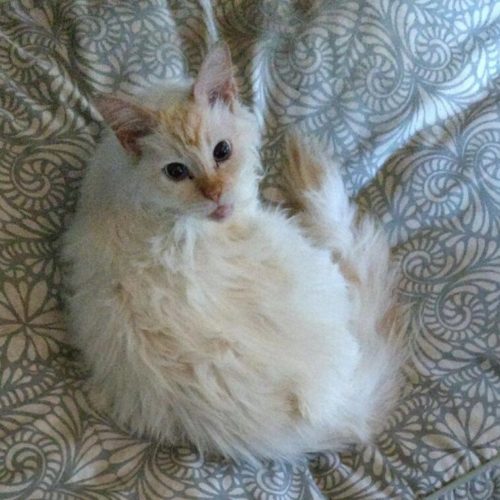
If you feed your kitties a raw diet and would like to see your story featured here, please contact me or leave a comment below.
And if you‘re interested in giving raw a try, check out our Raw Feeding and Transitioning Your Cat to Raw sections, and join the CatCentric group for help and support during your transition.

